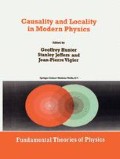Abstract
In his famous book, The Principles of Quantum Mechanics, Dirac stated that “... photon ... interferes only with itself. Interference between two different photons never occurs.” However, two-photon interference has been demonstrated experimentally. Was Dirac wrong? We report an new experiment in this paper. It demonstrated that two-photon interference can not be considered the interference of two photons. “Two-photon” is not two photons. Two-photon is a single entity, which is just like a photon. We may call it biphoton. Dirac was correct. Biphoton interferes only with itself.
Access this chapter
Tax calculation will be finalised at checkout
Purchases are for personal use only
Preview
Unable to display preview. Download preview PDF.
References
A. Einstein, B. Podolsky, and N. Rosen, Phys. Rev. 47, 777 (1935).
J.S. Bell, Physics 1. 195 (1964).
D.M. Greenberger, M.A. Home, A. Shimony and A.Zeilinger, Am. J. Phys. 58, 1131 (1990).
for example, see A.K. Ekert, J.G. Rarity, P.R. Tapster, and G.M. Plama, Phys. Rev. Lett. 69, 1293 (1992); C.H. Bennet, S. J. Wiesner, Phys. Rev. Lett. 69, 2881 (1992).
D.N. Klyshko, Soy. J. Quant. Elec., 10, 1112 (1980).
e.g.: A. Barenco, D. Deutsch, A. Ekert, and R. Jozsa, Phys. Rev. Lett. 74, 4083 (1995); T. Sleator and H. Weinfurter, Phys. Rev. Lett. 74, 4807 (1995); J.I. Cirac and P. Zoller, Phys. Rev. Lett. 74, 4091 (1995).
C.O. Alley and Y.H. Shih, Proceedings of the Second International Symposium on Foundations of Quantum Mechanics in the Light of New Technology, ed. M.Namiki, (1986); Y.H. Shih and C.O. Alley, Phys. Rev. Lett., 61, 2921, (1987).
C.K. Hong, Z.Y. Ou, and L. Mandel, Phys. Rev. Lett., 59, 2044, (1987).
e.g.: W.H. Louise11, A. Yariv, and A.E. Siegmann, Phys. Rev. 124, 1646 (1961); T.G. Giallorentzi and C.L. Tang, Phys. Rev. 166, 225 (1968); S.E. Harries, M.K. Osaman, and R.L. Byer, Phys. Rev. Lett., 18, 732 (1967)?;D.N. Klyshko, Photon and Nonlinear Optics,Gordon and Breach Science, New York, (1988). “Spontaneous Parametric Down Conversion” was called “Spontaneous Fluorescence” and “Spontaneous Scattering” by the pioneer workers, which is closer to the physics.
M.H. Rubin, D.N. Klyshko, Y.H. Shih, and A.V. Sergienko, Phys. Rev. A., 50, 5122 (1994).
see for example P.G. Kwiat, A.M. Steinberg, and R.Y. Chiao, Phys. Rev. A, 45, 7 729 (1992); J.D. Franson, Phys. Rev. A, 45, 3126 (1992); A.M. Steinberg, P.G. Kwiat, and R.Y. Chiao, Phys. Rev. A, 45, 6659 (1992); A.M. Steinberg, P.G. Kwiat, and R.Y. Chiao, Phys. Rev. Lett., 68, 2421 (1992); Y.H. Shih, and A.V. Sergienko, Phys. Lett. A, 186, 29 (1994).
R.J. Glauber, Phys. Rev. 130, 2529 (1963); 131, 2766 (1963).
Y.H. Shih and A.V. Sergienko, Phys. Rev. A, 50, 2564 (1994).
A.V. Sergienko, Y.H. Shih, and M.H. Rubin, J. Opt. Soc. Am. B, 12, 859 (1995).
In type-I SPDC, signal and idler are both ordinary (or extraordinary) rays of the crystal; however, in type-II SPDC they are orthogonal polarized, i.e., one is ordinary and the other is extraordinary.
This device is described in more details in D.V. Strekalov, T.B. Pittman, A.V. Sergienko, Y.H. Shih and P.G. Kwiat, Phys. Rev. A, 54. R1 (1996).
Author information
Authors and Affiliations
Editor information
Editors and Affiliations
Rights and permissions
Copyright information
© 1998 Springer Science+Business Media Dordrecht
About this paper
Cite this paper
Shih, Y.H., Strekalov, D.V., Pittman, T.D. (1998). Why Two-Photon but Not Two Photons?. In: Hunter, G., Jeffers, S., Vigier, JP. (eds) Causality and Locality in Modern Physics. Fundamental Theories of Physics, vol 97. Springer, Dordrecht. https://doi.org/10.1007/978-94-017-0990-3_49
Download citation
DOI: https://doi.org/10.1007/978-94-017-0990-3_49
Publisher Name: Springer, Dordrecht
Print ISBN: 978-90-481-5092-2
Online ISBN: 978-94-017-0990-3
eBook Packages: Springer Book Archive

